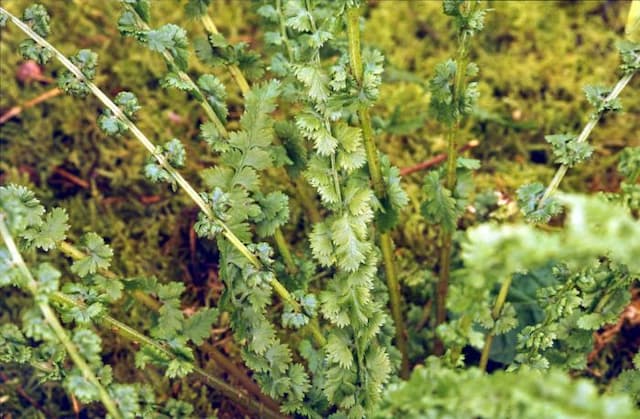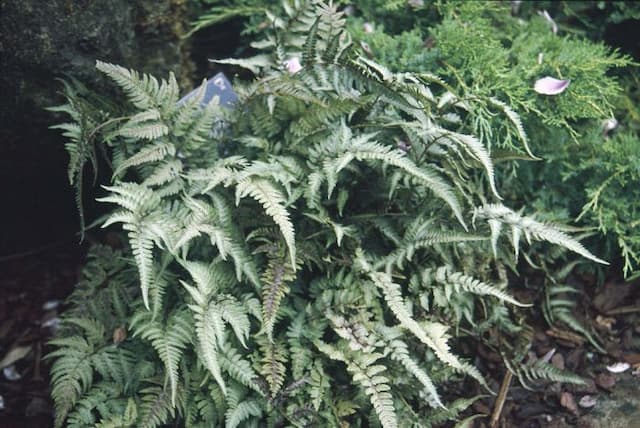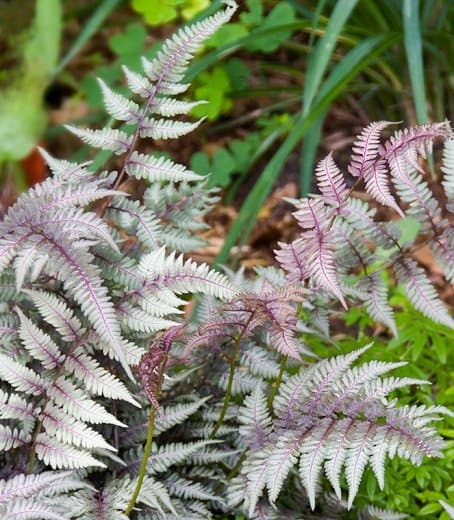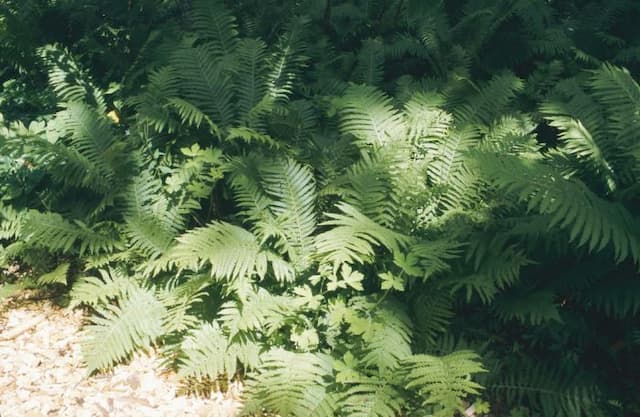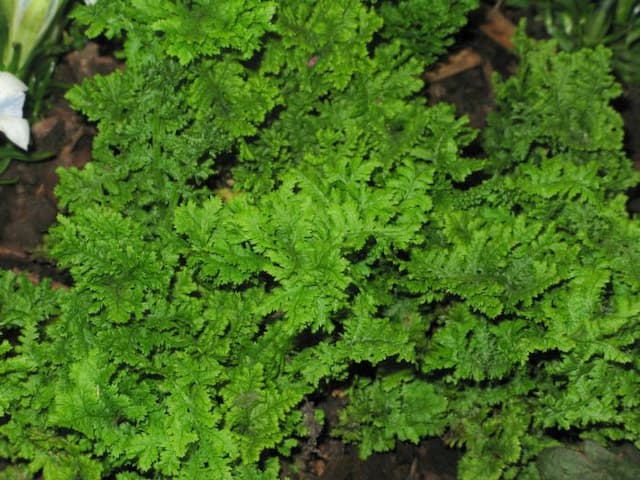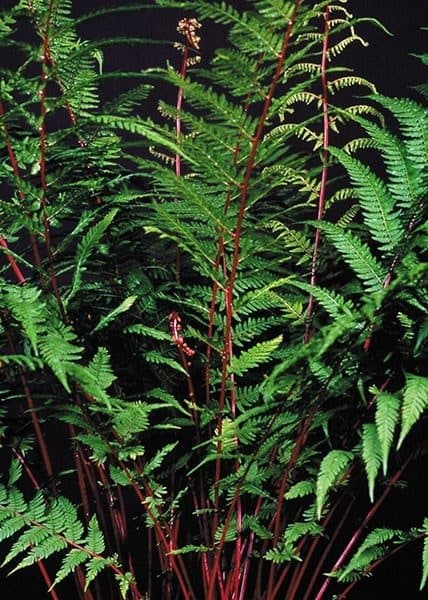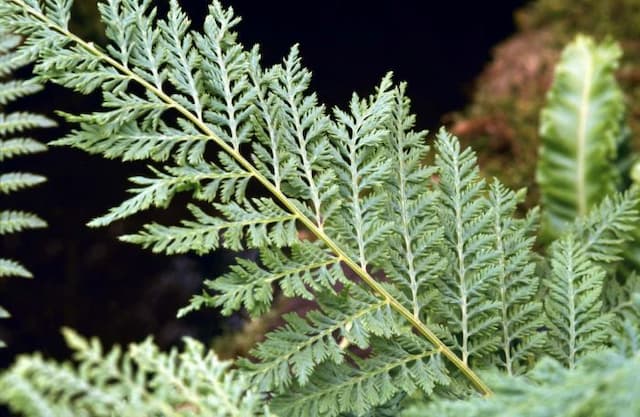Oak Fern Gymnocarpium dryopteris

ABOUT
Commonly known as the western oakfern, this plant boasts a delicate and airy appearance. Its fronds are thin and finely divided, creating a gentle, feathery look. The fronds emerge from a central point, unfurling elegantly as they mature. They are typically light to medium green in color, providing a vibrant texture to the forest floor. The western oakfern's leaves are composed of multiple small leaflets, and these are further divided into even tinier, lobed or toothed segments, giving it a soft, elaborate structure. The stems are slender and may have a slightly different hue, sometimes showing a hint of color that sets them apart from the green of the leaves. Adaptable to various environments, this plant often grows in clumps, forming a lacy undergrowth that can be particularly dense in ideal conditions. The enchanting and intricate leaf patterns of the western oakfern make it a delightful presence in its natural woodland settings, as well as in shaded garden landscapes where it adds a touch of elegance without overwhelming the surrounding flora with its size.
About this plant
 Names
NamesSynonyms
Oak Fern, Western Oakfern, Northern Oak Fern.
Common names
Dryopteris linnaeana, Nephrodium dryopteris, Polypodium dryopteris, Phegopteris dryopteris, Thelypteris phegopteris, Polystichum dryopteris, Aspidium dryopteris, Lastrea thelypteris, Phegopteris polypodioides, Dryopteris phegopteris, Gymnocarpium robertianum, Aspidium robertianum, Nephrodium robertianum, Thelypteris robertianum, Dryopteris robertiana.
 Toxicity
ToxicityTo humans
Oak Fern (Gymnocarpium dryopteris) is generally not considered toxic to humans. There is no significant evidence to suggest that the Oak Fern has any toxic properties that would lead to poisoning if ingested. Therefore, there are no known symptoms of poisoning or toxicity as a consequence of ingesting the Oak Fern.
To pets
Oak Fern (Gymnocarpium dryopteris) is not known for being toxic to pets. Similar to its effects on humans, there is no widespread documentation suggesting that Oak Fern is harmful to animals if ingested. Accordingly, there are no recognized symptoms of poisoning or known adverse effects associated with pets consuming any part of the Oak Fern plant.
 Characteristics
CharacteristicsLife cycle
Perennials
Foliage type
Deciduous
Color of leaves
Green
Height
1 foot [30 cm]
Spread
1 foot [30 cm]
Plant type
Herb
Hardiness zones
3
Native area
Eurasia
Benefits
 General Benefits
General Benefits- Ecosystem Support: Gymnocarpium dryopteris, commonly known as the oak fern, offers habitat and food for various insect species, playing a role in the local ecosystem's biodiversity.
- Soil Improvement: The oak fern contributes to soil health by adding organic matter as it decomposes, which improves soil structure and fertility.
- Shade Tolerance: This plant thrives in shaded areas, making it suitable for planting in woodland gardens or areas where other plants may not grow as well.
- Erosion Control: With its ability to grow in shaded and semi-shaded areas, the oak fern can help stabilize the soil and prevent erosion in forested environments.
- Aesthetic Appeal: The fern's delicate, lacy fronds add a touch of elegance and natural beauty to gardens and natural landscapes, providing a pleasing visual element.
- Low Maintenance: The oak fern is known for being a low-maintenance plant that requires minimal care once established, making it an easy choice for gardeners of all skill levels.
- Habitat Restoration: This fern species can be used in restoration projects to repopulate native plant communities and recover the ecological integrity of an area.
 Medical Properties
Medical PropertiesThis plant is not used for medical purposes.
 Air-purifying Qualities
Air-purifying QualitiesThis plant is not specifically known for air purifying qualities.
 Other Uses
Other Uses- The fronds of Gymnocarpium dryopteris, commonly known as Oak Fern, can be used as a natural green dye for textiles and craft projects.
- Oak Fern can be included in floral arrangements and terrariums for its delicate foliage and texture.
- This plant is sometimes used in educational settings to help students learn about fern life cycles and spore reproduction.
- Gymnocarpium dryopteris can be planted in shady areas to prevent soil erosion because its root system helps stabilize the ground.
- Landscapers may use Oak Fern as a ground cover in woodland gardens to create a lush, green understory.
- The dried fronds of Oak Fern are used by artisans to create rustic and natural decorative pieces.
- Oak Fern is utilized in garden designs to create contrasts with its light, feathery fronds among darker foliage plants.
- Biologists and ecologists surveying the presence of Oak Ferns to indicate a healthy and undisturbed woodland ecosystem.
- The plant’s ability to grow in deep shade can be exploited to green urban spaces with limited sunlight.
- Oak Fern might be featured in botanical art and photography due to its aesthetic appeal and intricate leaf patterns.
Interesting Facts
 Feng Shui
Feng ShuiThe Oak Fern is not used in Feng Shui practice.
 Zodiac Sign Compitability
Zodiac Sign CompitabilityThe Oak Fern is not used in astrology practice.
 Plant Symbolism
Plant Symbolism- Resilience - Often found in bare and rocky soils, Gymnocarpium dryopteris, commonly known as Northern Oak Fern, symbolizes the ability to thrive in challenging conditions.
- Humility - Due to its modest size and unassuming presence in the forest undergrowth, the Northern Oak Fern represents humility and unpretentiousness in various cultural contexts.
- Protection - Ferns in general are thought to offer protection and have been used in traditional medicine, which can extend symbolically to the Northern Oak Fern, suggesting shielding and safeguarding qualities.
- Growth and Renewal - Ferns often symbolize new beginnings and the unfurling of new growth, as seen in their fiddleheads; this can apply to the Northern Oak Fern, conveying hope and renewal.
 Water
WaterThe Oak Fern should be watered regularly to maintain evenly moist soil, particularly during its active growth season in spring and summer. Aim to water it when the top inch of soil feels dry, which could be about once a week, depending on environmental conditions. Use lukewarm water and gently pour it around the base of the plant until the soil is saturated and excess water begins to drain from the bottom. Be cautious not to overwater; the Oak Fern does not like to sit in waterlogged soil. The precise amount of water can vary, but a general rule might be to use approximately half a gallon every two weeks for a medium-sized plant, adjusting as necessary for the size of your fern and the humidity of your environment.
 Light
LightThe Oak Fern prefers dappled shade or partial shade, similar to its natural woodland habitat. It thrives best in bright, indirect light away from direct sunlight that can scorch its delicate fronds. The ideal spot for an Oak Fern would be a north-facing or east-facing window with some light filtering curtains or placed a few feet away from a south-facing window. These light conditions will mimic the forest understory lighting and promote healthy growth.
 Temperature
TemperatureThe Oak Fern favors cool to moderate temperatures, ideally between 60 and 70 degrees Fahrenheit. It can survive temporarily in temperatures as low as 50 degrees Fahrenheit, but prolonged exposure to cold can be detrimental. Similarly, temperatures above 75 degrees Fahrenheit can stress the plant. This fern is not tolerant of extreme heat or cold, so it should be kept away from drafts and heat sources.
 Pruning
PruningPruning the Oak Fern is generally not necessary, as it maintains a tidy form naturally. However, you can trim off any dead or damaged fronds at their base to keep the plant looking its best. This light pruning can be done at any time of the year as needed but is best done in the spring before new growth begins. Pruning not only tidies the plant but also encourages healthy new fronds to develop.
 Cleaning
CleaningAs needed
 Soil
SoilOak fern thrives in a mix that mimics its natural woodland habitat; a mix with plenty of organic matter such as compost or leaf mold is ideal. The soil should be well-draining while retaining moisture, and its pH optimal range is slightly acidic to neutral, between 5.5 and 7.0.
 Repotting
RepottingOak fern typically does not require frequent repotting as it is a slow-growing plant. Repotting every 2-3 years or when the plant outgrows its current container is sufficient to maintain its health.
 Humidity & Misting
Humidity & MistingOak fern prefers high humidity, ideally between 60% and 80%. While it can tolerate lower humidity levels, consistently high humidity helps simulate its natural environment and keeps the fronds lush.
 Suitable locations
Suitable locationsIndoor
Provide shade, cool temps, and high humidity for oak fern.
Outdoor
Plant oak fern in shade, moist soil, protect from wind.
Hardiness zone
3-8 USDA
 Life cycle
Life cycleGymnocarpium dryopteris, commonly known as the western oakfern, begins its life cycle as a spore released from mature ferns. These spores germinate in moist, shaded soil to form a small, heart-shaped gametophyte (prothallus), which houses both male and female reproductive organs. Fertilization occurs when water allows sperm to swim to the egg, producing a zygote that subsequently grows into a new sporophyte—the leafy fern plant we recognize. This sporophyte matures and develops fronds that unroll from a fiddlehead into a full leaf, which is capable of photosynthesis. On the underside of mature fronds, sori develop, containing sporangia where meiosis takes place, resulting in new spores ready to disperse and start the cycle anew. Throughout its life, the western oakfern undergoes a seasonal cycle of growth and dormancy, with fronds dying back in the winter and regrowing in the spring.
 Propogation
PropogationPropogation time
Spring to summer
Gymnocarpium dryopteris, commonly known as the oak fern, can be propagated primarily through the division of rhizomes. The best time to undertake this method is in the spring season, as the plant emerges from dormancy and the ground is moist, which facilitates easier division and re-establishment. To propagate the oak fern by division, one should carefully dig up an established plant and gently separate the rhizomes into smaller sections, ensuring that each section has at least a couple of fronds or growing points. These rhizome sections can then be replanted in moist, well-drained soil, at a depth of about 1 to 2 inches (2.5 to 5 cm). It is essential to keep the newly planted divisions well-watered until they are established and showing signs of new growth. This vegetative method of propagation maintains the genetic consistency of the plant and is often the preferred method for expanding or sharing the oak fern.
